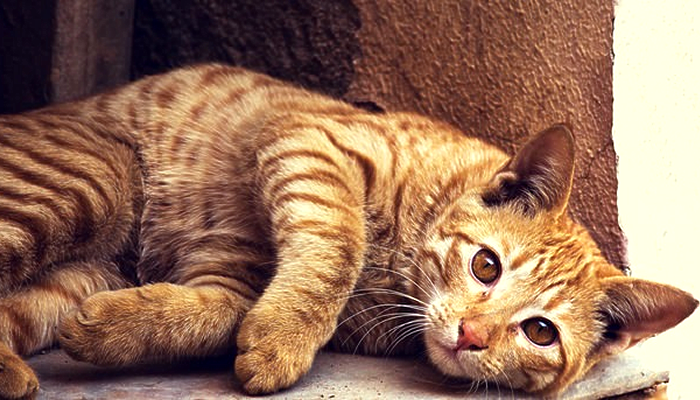Kosh is a beautiful, sweet, two-year-old orange tabby. His mom brought him because he had stopped eating over the weekend. Nothing else seemed to be wrong except he wasn’t eating and maybe he wasn’t quite as active as normal.
Because cats who don’t eat can contract fatty liver quite easily,
also called hepatic lipidosis, we hospitalized Kosh to figure out why he wasn’t eating, and to do everything possible to get him started eating quickly. Initial bloodwork really didn’t show anything dramatic, very slightly anemic, which is a low red blood cell count, but nothing else abnormal. Temperature was normal, heart and lungs were clear, eyes were bright, he was not raspy in his chest or head, he was urinating normally, there was no infection in his urine, nothing under his tongue, no sores in his mouth, everything else appeared to be normal. Kosh started receiving fluids and we offered many different kinds of tasty foods to eat. The stalemate continued for several days: no eating, no worse, continued fluids, continued offering many different taste treats. His normal food at home was a grocery store dry cat food but he would eat chicken and tuna when his owner offered it. It became obvious that Kosh was going to hold out much too long and we really needed to get to the underlying problem. Repeat of the blood work showed exactly the same thing – very mild anemia and not a single other thing abnormal. An x-ray of the kitty showed a little thickening of the intestinal walls, often associated with inflammation, but nothing obvious. Because there’s always a possibility of something in the intestines that can’t be seen on a normal x-ray, Kosh received a barium swallow. Talk about a great cat! It’s not every cat who will swallow strawberry banana flavored barium without throwing a giant hissy fit; Kosh drank it down like an angel. The next x-ray, with the barium just in his stomach, showed the problem: stomach ulcers. Over the next several hours, the barium traveled through Kosh’s intestines and made it to the colon – we knew there were no obstructions.
Anti-ulcer medication was started and within 24 hours, Kosh was eating again!
Talk about just in time! The last thing we wanted was a liver problem on top of the mysterious not eating issue. His mom was awesome for not waiting to get him in to the clinic. And the great news was that now that we knew the cause so we knew how to treat it. The next question to ask is why would a healthy, laid-back, two-year-old cat have a stomach ulcer? It is common in pigs and cattle that finely ground corn can cause stomach ulcers. Finely ground corn, called “fines”, has led to bleeding stomach ulcers and death more than once. While this apophysis is the most likely reason for an ulcer, other things that commonly happen to cats that eat dry food based on corn and lose their appetite would be related to mold the corn causing nausea. If that had been the case fluids and a couple of days of good food should’ve been enough for this kitty. Regardless, this awesome Tabby went home eating real meat, chicken, beef, anything he could get his paws on.


Oh he looks just like my boy! Orange tabbies are the best. My 13 yo was Dx with hyperthyroidism last year, put on .1 ml tapazole once daily, everything’s been great…until day before yesterday. Appetite fell off, vomiting, diarrhea, the whole mess. He’s hungry and trying to eat but most of it comes back up about an hour later and the diarrhea is pretty bad. He’s going in to the vet first thing in the morning to see what’s going on. I fear the disease has gotten worse because he’s been on meds for 8mos, eating and drinking fine, still thin but active, happy, stools normal, no vomiting, and now this. I think we’ll probably end up at Radiocat. I have a great vet but thought about also discussing this with my holistic vet too. But everything I’ve read seems to point to isotope treatment as the gold standard and I’ll pay whatever to get him better. Hate to see him go thru this although vet says he has patients on Tap for years doing fine. So glad Kosh is okay! What a sweetie! Wish us luck…hate it when my baby is sick. P.s. He’s been on Natures Instinct Variety canned chicken and beef. NO kibble since this happened. Looking for the best food but will wait to see what lab says.
I just started feeding my cats Abady’s raw frozen cat food which they like, but then I read this article and noticed that Abady’s raw food, although mostly meat, contains crushed kibbled corn. Should I stay away from this ?
If they can guarantee the corn is GMO, then it’s an acceptable calorie source. Otherwise, it is an interesting selection of a grain to include when there are so many others out there.
Good for you for switching your kitties to raw – and them for accepting the change!! Stick with it for them and I’m sure they will bloom!!
Thanks Dr. Cathy, but are you saying that genetically modified corn is safer for cats? I usually try to stay away genetically modified products.
GMO products are not safe, sorry you misunderstood my comment.